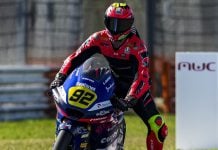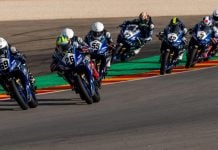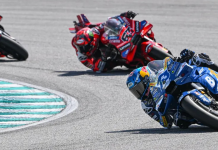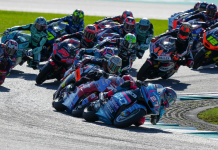From a competition bulletin issued by AMA Pro Racing:
To: All Licensed Road Racers and Season Credential Holders
From: Rob King, Technical Manager
Subject: 2003 Road Race Rule Changes and Additions
The following rule changes and additions are approved for the 2003 Chevy Trucks US Superbike Championship series. If you are a pro racer and have applied for your 2003 license, you will be receiving a new rule book with your license. The book will also be posted on AMA Pro Racing’s website at amaproracing.com. Date of implementation for all changes and additions will be January 1, 2003.
The Superbike equipment regulations are listed here in a format which closely follows that of the rule book. The 1000cc multi-cylinder category is new for 2003 and should provide an excellent way for many racers and teams to step-up to Superbike. The four-cylinder 750cc Superbikes have been given a boost to 800cc in order to help match their performance to the 1000cc twins. In addition, the minimum weight requirement for all Superbikes has been increased to 370 pounds to help balance the competition between all engine configurations and displacements.
Following the Superbike regulations, the changes to Supersport and Superstock are listed showing the current rules, the changes and the reasons for the changes. Rule book text is not fully formatted at this time, but it will be very close to this wording.
Superbike Equipment Categories
The Superbike class includes two broad categories of equipment regulations. One set of rules applies to 750cc four cylinders, 900cc three cylinders and 1000cc twin cylinders. These rules can be found in Section A. A separate set of rules applies to 1000cc multi-cylinders. Those are listed in Section B.
Both categories of Superbikes are also subject to the requirements in Equipment Standards General and Approval of Motorcycles. Superseded or redesigned parts controlled by these rules must be submitted by the motorcycle’s manufacturer to AMA Pro Racing for review and approval before use in competition. In addition, such parts must then be listed in the current OEM parts list as supplied to AMA Pro Racing. Motorcycle components not specifically controlled by these rules may be modified, removed or replaced.
A. Superbike Equipment – 750cc Four Cylinders, 900cc Three Cylinders and 1000cc Twin Cylinders
1. Approval of Superbikes – 750cc Four Cylinders, 900cc Three Cylinders and 1000cc Twin Cylinders
(a) Only approved motorcycles may be used in Superbike competition. The AMA will only review applications for homologation from motorcycle manufacturers or their distributors. Homologation applications and procedures are available through the AMA Pro Racing home office.
(b) Once a motorcycle has been approved, it may be used until such time that it may be disqualified by new rules or rule changes.
(c) Compliance with homologation requirements will not guarantee AMA approval. Homologation may be withheld or withdrawn for any reason the AMA deems in the best interest of Superbike competition.
(d) 750cc four-cylinder, 900cc three-cylinder and 1000cc twin-cylinder motorcycles must be street certified in an FIM-recognized country and available through US distributors or retail dealers. A list of eligible motorcycle models is available from the AMA Pro Racing home office. Minimum import requirement is as follows:
All manufacturers – 50 units
2. Engine Displacements
551cc – 750cc 4-stroke four cylinders (See Overbore Allowance)
551cc – 900cc 4-stroke three cylinders
551cc – 1000cc 4-stroke twin cylinders
3. Overbore Allowance
(a) Engines with displacements originally within the 551 – 750cc four cylinders range are permitted to have cylinder bores increased by a maximum of 2mm, with the resulting displacement not to exceed 800cc.
(b) 551cc – 900cc three cylinders and 551cc – 1000cc twin cylinders are not allowed an overbore. Displacement limits are absolute.
4. The following engine components may not be altered from the originally approved model except as noted:
(a) Engine type, configuration and stroke
(b) Crankshaft configuration
(c) Cam drive location in the engine
(d) Number of valves
(e) Material and castings of cylinders, cylinder heads, and crankcases. Cylinder liners or coatings may be replaced or added, provided the original type cylinder casting is utilized.
(f) The major element used as material in the crankshafts and camshafts.
(g) The number of carburetors or fuel injection throttle bodies (See Superbike Component Claiming Rule)
(h) Variable-length carburetor/fuel injection intake tract devices that function while the engine is operating are prohibited.
(i) Fuel injection is permitted only on motorcycles on which it is standard equipment. Aftermarket systems are not permitted. Originally approved throttle bodies must be retained but may be modified.
5. The following items may not be altered from the originally approved model except as noted:
(a) Stock main frame
(1) Frame must display vehicle identification number.
(2) Strengthening gussets and tubes may be added, but none may be removed. (3) Accessory brackets (radiator, shock reservoir, stands, etc.) may be changed, relocated, added or removed. Holes may be drilled only for the purpose of attaching brackets or other components.
(4) Frames may be painted, powder coated, polished or surface treated.
(b) Fairing and bodywork may be modified or replaced with aftermarket parts which resemble the originally approved parts in design and which maintain similar dimensions.
(1) With permission from the Race Manager or the Chief Technical Inspector, fairing or bodywork may be removed only if damaged at that particularmeet.
(2) See also Fairing and Bodywork in Equipment Standards – All Road Race Motorcycles.
(c) Wheels may be replaced with aftermarket parts provided they are not constructed of carbon fiber or carbon composites. Maximum rear wheel rim width is 6.25″.
(d) Forks and shock absorbers may be modified or replaced with aftermarket parts.
(1) Shocks may be relocated but the original suspension type (dual shock or single shock) must be retained.
(2) Active, semi-active or computer-controlled suspension units are not permitted.
(3) See also Superbike Component Claiming Rules.
(e) Fuel tank, or bodywork installed in the traditional fuel tank location, may be modified or replaced with aftermarket parts provided the side view profile remains visibly the same as the originally approved model.
(1) Fuel tanks may be modified to achieve a maximum capacity of 24 liters (6.341 gallons).
(2) The fuel cap may be replaced with a quick-fill coupler and additional vent coupling. Both couplers must be installed in the top of the tank. Maximum inner diameter of quick-fill or vent coupler is 63.5mm (2.5″). See also Dump Cans for Refueling in Equipment Standards – All Road Race Motorcycles.
6. Weight: All Superbikes minimum weight requirement – 370 pounds
7. Superbike Component Claiming Rules – 750cc Four Cylinders, 900cc Three Cylinders and 1000cc Twin Cylinders
(a) The following components of 750cc four-cylinder, 900cc three-cylinder and 1000cc twin-cylinder Superbikes are subject to claiming by competitors or the AMA at the prices listed when used in Superbike competition:
Fuel injection throttle body assemblies and electronic control module:
Twin cylinders – $2,500
Four cylinders – $3,500
Four-cylinder carburetor assembly – $3,500
Fork assemblies – $7,500
Shock absorber assembly – $2,500
(b) Claims will be accepted only from riders who competed in the same final event as the rider whose equipment is being claimed.
(c) Claim form and cash or a certified check must be submitted to the Chief Steward or Tech Inspector within 30 minutes of the posting of results.
(d) Once a claim is made, it may not be withdrawn.
(e) Competitors or teams cannot claim their own equipment.
(f) Should there be more than one claim for the same equipment, a drawing will be held to determine the successful claimant.
(g) Upon notice, the rider whose equipment is being claimed must present the motorcycle for impound at tech inspection.
(h) The owner of the claimed equipment must then accept the fee and deliver the specified components.
(i) An eligible claimant is permitted only one successful claim per season.
(j) Teams or individual competitors who have had a component claimed are not subject to an additional claim for a period of four meets within a season.
B. Superbike Equipment – 1000cc Multi-cylinders
1. Approval of Superbikes – 1000cc Multi-cylinders
(a) Only approved motorcycles may be used in Superbike competition. The AMA will only review applications for homologation from motorcycle manufacturers or their distributors. Homologation applications and procedures are available through the AMA Pro Racing home office.
(b) Once a motorcycle has been approved, it may be used until such time that it may be disqualified by new rules or rule changes.
(c) Compliance with homologation requirements will not guarantee AMA approval. Homologation may be withheld or withdrawn for any reason the AMA deems in the best interest of Superbike competition.
(d) 1000cc multi-cylinder motorcycles must be street-certified in the US and available through US retail dealers. A list of eligible motorcycle models is available from the AMA Pro Racing home office. Minimum import requirements are as follows:
Manufacturers with 200 or fewer US retail dealers – 300 units
Manufacturers with more than 200 US retail dealers – 400 units
2. Engine Displacements
901cc – 1000cc 4-stroke three or more cylinders
3. The following engine components may not be altered from the originally approved model except as noted:
(a) Engine type, configuration and stroke
(b) Stock crankshaft
(1) Bearing surfaces may be polished or surface treated.
(2) Balancing is permitted but only by the same method used by the OEM. For example, heavy metal (i.e. Mallory metal) inserts are not permitted unless they were originally specified by the OEM.
(3) Attachment of aftermarket ignition components or sensors is permitted.
(c) Stock cylinders, cylinder heads and crankcases
(1) Machining, welding and the addition of material are permitted.
(2) Cylinder liners or coatings may be replaced or added.
(d) Aftermarket or modified valves, springs, retainers and other valve-train components are permitted. The original number of valves must be maintained.
(1) Valve diameter, including stem, must remain stock.
(2) Valves must be made of the same basic material as the OEM valves.
(3) Valves must remain in the same location and at the same angle as originally installed by the OEM.
(e) Aftermarket camshafts are permitted, but cam lift and the resulting valve lift must be no greater than stock. Aftermarket cam drive components are permitted, but must be in the same engine location as the OEM drive.
(f) Aftermarket or modified, stock-type clutches (wet-type cannot be changed to dry-type) with back-torque limiting capabilities are permitted.
(g) Transmission shafts and gear sets – Two options are available for these components:
(1) Stock transmission shafts and gear sets – Undercutting and surface treatments are the only modifications allowed.
(2) Approved (homologated) transmission shafts and gear sets – Each manufacturer will be permitted one alternative set of gear ratios per approved model. Only shafts and gears sold through the OEM distributor or its dealers are permitted. Approved shafts and gears may be interchanged with stock components. Undercutting and surface treatments are the only modifications allowed.
(3)Approved transmission components must be available individually and as a set to AMA Superbike-licensed riders for the entire current season (or the remaining part of the season). Orders determined to be legitimate by AMA Pro Racing and accompanied by a 50% deposit must be filled within 15 business days of receipt by the OEM distributor or dealer.
(4) Retail price of individual approved transmission components may not exceed twice the manufacturer’s suggested retail price of the components they replace. If a manufacturer does not offer optional AMA-approved transmission components, then the stock components must be utilized.
(h) Fuel injection throttle-body assemblies – Two options are available for these components:
(1) Stock throttle-body assemblies – Fuel delivery through the standard injectors may be changed but no other modifications are permitted. Variable-length fuel injection intake tract devices that function while the engine is operating are prohibited.
(2) Approved (homologated) throttle-body assemblies – Each manufacturer will be permitted one alternative throttle-body assembly per approved model. Only throttle bodies sold through the OEM distributor or its dealers are permitted. Fuel delivery through the approved throttle-body injector nozzles may be changed but no other modifications are permitted. Variable-length fuel injection intake tract devices that function while the engine is operating are prohibited.
(3) Approved throttle bodies and replacement parts must be available to AMA Superbike-licensed riders for the entire current season (or the remaining part of the current season). Orders determined to be legitimate by AMA Pro Racing and accompanied by a 50% deposit must be filled within 15 business days of receipt by the OEM distributor or dealer.
(4) Retail price of throttle-body assemblies and replacement parts may not exceed twice the manufacturer’s suggested retail price of the components they replace. If a manufacturer does not offer optional AMA-approved throttle bodies, then the stock components must be utilized.
4. The following items may not be altered from the originally approved model except as noted:
(a) Stock main frame
(1) Frame must display vehicle identification number.
(2) Strengthening gussets and tubes may be added, but none may be removed.
(3) Accessory brackets (radiator, shock reservoir, stands, etc.) may be changed, relocated, added or removed. Holes may be drilled only for the purpose of attaching brackets or other components.
(4) Frames may be painted, powder coated, polished or surface treated.
(b) Fairing and bodywork may be modified or replaced with aftermarket parts which resemble the originally approved parts in design and which maintain similar dimensions.
(1) With permission from the Race Manager or the Chief Technical Inspector, fairing or bodywork may be removed only if damaged at that particularmeet.
(2) See also Fairing and Bodywork in Equipment Standards – All Road Race Motorcycles.
(c) Wheels may be replaced with aftermarket parts provided they are not constructed of carbon fiber or carbon composites. Maximum rear wheel rim width is 6.25″.
(d) Forks and shock absorbers may be modified or replaced with aftermarket parts.
(1) Shocks may be relocated but the original suspension type (dual shock or single shock) must be retained.
(2) Active, semi-active or computer-controlled suspension units are not permitted.
(3) See also Superbike Component Claiming Rules.
(e) Fuel tank, or bodywork installed in the traditional fuel tank location, may be modified or replaced with aftermarket parts provided the side view profile remains visibly the same as the originally approved model.
(1) Fuel tanks may be modified to achieve a maximum capacity of 24 liters (6.341 gallons).
(2) The fuel cap may be replaced with a quick-fill coupler and additional vent coupling. Both couplers must be installed in the top of the tank. Maximum inner diameter of quick-fill or vent coupler is 63.5mm (2.5″). See also Dump Cans for Refueling in Equipment Standards – All Road Race Motorcycles.
5. Weight: All Superbikes minimum weight requirement – 370 pounds
6. Superbike Component Claiming Rules – 1000cc Multi-cylinders
(a) The following components of 1000cc multi-cylinder Superbikes are subject to claiming by competitors or the AMA at the prices listed when used in Superbike competition:
Fork assemblies – $7,500
Shock absorber assembly – $2,500
(b) Claims will be accepted only from riders who competed in the same final event as the rider whose equipment is being claimed.
(c) Claim form and cash or a certified check must be submitted to the Chief Steward or Tech Inspector within 30 minutes of the posting of results.
(d) Once a claim is made, it may not be withdrawn.
(e) Competitors or teams cannot claim their own equipment.
(f) Should there be more than one claim for the same equipment, a drawing will be held to determine the successful claimant.
(g) Upon notice, the rider whose equipment is being claimed must present the motorcycle for impound at tech inspection.
(h) The owner of the claimed equipment must then accept the fee and deliver the specified components.
(i) An eligible claimant is permitted only one successful claim per season.
(j) Teams or individual competitors who have had a component claimed are not subject to an additional claim for a period of four meets within a season.
Supersport and Superstock
1. Current rule: Electric ignition cutout shift devices are currently not permitted.
Change: Electric ignition cutout shift devices are permitted. These devices may not physically operate the shift lever or the shifting mechanism.
Reasons for Change: Aftermarket electronic ignition interrupting shift kits are reasonably priced and readily available.
2. Current rule: Stock cam chain tensioners must be utilized.
Change: Aftermarket cam chain tensioners are permitted.
Reasons for Change
This change does not affect engine power output but may positively affect reliability under racing conditions. Aftermarket units are reasonably priced and readily available.
3. Current rule: Except as noted in the rule book, cylinder heads, cylinders and engine cases must remain stock with no modifications, metal removal, blueprinting, or surface treatments.
Change: Machining of gasket surfaces of cylinder heads, cylinders or engine cases for the purpose of increasing or balancing compression only is permitted.
Reasons for Change: The increased compression may help to balance the competition between brands and will eliminate the need for technical inspections of deck heights.
4. Current rule: Cylinder head and base gaskets may be replaced only with OEM stock parts. All other gaskets may be replaced with duplicate aftermarket parts.
Change: All gaskets may be replaced with aftermarket gaskets.
Reasons for Change: With the removal of a deck height requirement, the need for stock gaskets is no longer necessary.
Should you have any questions concerning these changes, please contact Technical Manager Rob King at (614) 856-1910, extension 1230 or Director of Competition Merrill Vanderslice at (614) 856-1910, extension 1262.
AMA Pro Racing Releases Rule Changes, Including 1000cc Superbike Parts Claiming
AMA Pro Racing Releases Rule Changes, Including 1000cc Superbike Parts Claiming
© 2002, Roadracing World Publishing, Inc.






